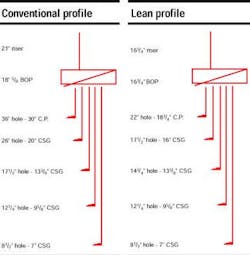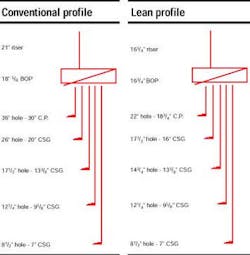DEEPWATER OPERATIONS: Leaner profile drilling system
Drilling and completion of oil and gas wells are primary cost elements in deepwater activities and are major drivers for technological innovation. A technique to reduce the clearance between the casing and the borehole, permitting 'slimmer' well profiles, has proven effective in cutting drilling costs in certain onshore drilling environments.
'Lean profile drilling' offers opportunities for re-thinking and re-shaping the drilling approach in deepwater, such as replacing the conventional drilling rig of an existing semisubmersible with a lightweight hydraulic rig. This step would expand the capabilities of the drilling unit to deeper water and cut costs. The lean profile technique (LPDT) is an improved drilling method that permits hole casings to be run in within an almost constant clearance throughout the well profile of 1.5-in. The technique employs close directional drilling control to eliminate tortuosity and geometrical irregularities in the wellbore. The procedure requires:
- Automatic control of well trajectory, whether vertical or deviated
- Use of bits with dog sub and adequate roller reamers to guarantee hole regularity and calibration
- Use of drilling muds with chemical and rheological properties that assure control of hole instability
- Constant control of drilling parameters to keep the hole curvature within specified limits.
Straight hole drilling
One of the automated drilling tools available to use with the technique is the straight-hole drilling device (SDD), a vertical drilling tool developed jointly by ENI Agip Division and Baker Hughes Inteq. The tool is capable of maintaining a perfect vertical trajectory, controlling it on a closed loop principle. The SDD continuously adjusts the trajectory through applying a side force generated at the bit by three ribs, hydraulically actuated by dedicated electronics. Continuous control of the inclination, and thus of the vertical course, is the best guarantee of achieving minimum tortuosity in the well.
Once a perfect vertical and well-calibrated hole has been drilled, further precautions must be adopted:
- Use of flush or near-flush type casing connections. An integral connection named A-SFC (Agip Semi Flush Connection) has been developed, which provides adequate compression and torsional strength/efficiency.
- Verification of the perfect linearity of the casings. API-allowed tolerances are not acceptable since they may prevent the casing from being landed safely at setting depth. This issue must be properly addressed before running casing.
- Limited use of centralizers
- Control of casing running speed to avoid dangerous surge/swab effects
- Use of suitable cementing casing shoes equipped with fill-up devices
- Use of special cement slurries with appropriate fluidity and mechanical resistance.
Casing program
A key consideration for application of the SDD/lean profile technique to deepwater is the casing program. A conventional profile would call for 30-in., 20-in., 13 3/8-in, 9 5/8-in., with a 7-in. liner. The 30-in. casing or conductor pipe is connected to a low pressure, 30-in. housing, while the 20-in. casing is connected to a high pressure 18 3/4-in. wellhead housing.
Onshore experience with lean profile drilling suggests a different casing scenario - 20-in., 16-in., 13 3/8-in., 9 5/8-in., also with a 7-in. liner. With this program, the required high pressure wellhead is 16 3/4-in. with a 17-in. drilling riser. This profile offers important benefits in terms of space and load availability on the drilling vessel. In fact, not only is space occupied by the stored drilling riser dramatically reduced, but also the total weight is diminished, allowing additional materials to be stored onboard.
Another benefit is the potential to increase the water depth capability of the rig, due to the application of the unit's pulling capability to a lower riser weight. However, the unit's mooring system must also be taken into account, and this could prove to be a limitation.
Use of a vertical drilling system such as the SDD has already allowed the deep offshore drilling technique to be changed. In fact, the potential for drilling straight hole vertical sections with very high accuracy has allowed the first two casing strings to be landed in one run. Starting from this premise, a different, more challenging profile could be attempted - 16-in., 14-in., 11 3/4-in., 9 5/8-in., 7 3/4-in. This would heighten the benefits outlined above, although limitations relating to the drilling vessel's mooring capacity would remain.
Considering just the possibility of landing the first two casing strings in one run, it has already been possible to save five days out of eight days in total, which can be a significant cost reduction in deepwater operations.
Running operations
Some operators employ a different approach based on the slender well technique, which consists of eliminating one casing string (surface 20-in.), installing a smaller subsea wellhead, reducing the drilling riser to 14-in. diameter with a 4 1/2-in. ID choke and kill lines, also reducing the rig size. Some of these operators claim to have achieved substantial rig savings. However, the lean profile technique is different, because there is no reduction in the number of casing strings. Of course, depending on the operating scenario, this presents pros and cons, just like the slender well technique. Key aspects to be considered are:
- The reduced diameters affect the riser joints (including the amount of buoyancy needed), in addition to the diverter ass-embly, the lower marine riser package, and the blowout preventer (BOP) stack.
- All the mechanical components will become lighter, and therefore easier to handle on the rig. Running and retrieval time will be reduced, benefiting the economics of the drilling operation.
- The rig's tensioners will be able to support a larger percentage of the overall riser weight, so the amount of buoyancy that has to be mounted around each joint is decreased.
- Deck space required for storage decreases due to the small diameters and reduced buoyancy.
- The reduced weight and size also mean that the rig will have additional capacity for loading parts needed for the subsequent completion operations. This in turn cuts the number of loading/offloading operations to the various supply boats.
- Rate of penetration during drilling increases due to the reduced amount of cuttings.
- Due to the smaller cross-section of the well and the riser, the amount of drilling and completion fluids and cement to be stored on the rig is greatly reduced. Furthermore, the size of the rig's mud processing and mixing equipment can also be reduced because of the smaller volumes handled.
- The reduced strength of the BOP and lower marine riser package connectors is counterbalanced by the reduced bending moment at the riser bottom, due to the fact that the riser pipe is more flexible, and also because the fluid dynamic forces acting on the riser string are proportional to the pipe diameter.
- Because of the smaller annulus between the drilling riser and the string, the velocity of the cuttings back to the surface increases substantially. This makes use of a return fluid booster line connected to one of the BOP stack outlets - standard practice with conventional drilling systems - unnecessary.
- The cost of consumables, such as drilling mud and cement, comes down owing to the reduced quantities needed. Also, the overall casing cost falls due to the smaller amount of material involved in the casing process.
- As the tubing hanger and Christmas tree are smaller than conventional ones, the initial capital cost of the wellhead equipment is also reduced.
MUX/EH BOP impact
The consequences of the reduced riser size as listed above will likely have no significant impact on the configuration of the MUX/EH BOP control system. Advantages envisaged are:
- Faster BOP closing times, since less fluid is needed to operate the actuators
- Decreased testing time on the various components due to the smaller volumes to be tested (BOP actuators, connector chambers).
Adoption of smaller riser diameters necessitates appropriate riser analyses. Initial work has suggested that a tapered stress joint (TSJ) appears preferable to a customary flex joint (FJ). Use of a TSJ increases the operating envelope, thus reducing potential idle rig time. The TSJ allows the transition angle between the riser and the lower marine riser package to be smooth rather than sharp, as is the case for systems using a flex joint. Moreover, as the TSJ replaces not only the FJ but also the adapter spool and the flex loops for the choke and kill lines, the overall cost of the lower marine riser assembly is greatly reduced. Saipem has used a tapered stress joint successfully in its completion/workover riser system.
Hydraulic drilling unit
Use of hydraulic drilling rigs for a semisubmersible also offer synergies with the lean profile technique. Among the improvements evident over a standard drawworks-based rig are those arising from the different hoisting and compensation system and from the lower weight and center of gravity.
A comparison between a 650-ton ram rig type and a 650-ton conventional drawworks rig type for semisubmersibles revealed a load savings in the range of 38-440 metric tons, and a 5-6 meter lower center of gravity. The first element has a beneficial impact on the variable load, as it allows the floating drilling unit's storage capacity to be increased, or alternatively, the water depth capability to be raised, as it then becomes possible to manage a longer drilling riser. The lower center of gravity has a positive influence on the vessel's stability.
The main limitation of a hydraulic drilling rig in such an environment appears to be tripping velocity, as most existing rigs are double ram type. However, triple ram rig types are coming onto the market, thereby closing the gap on conventional drawworks-type rigs in this regard. The hydraulic rig also offers potential synergies with the SDD/lean profile technology, because of the lower weights involved when operating with slimmer casing profiles.
Editor's Note: This is an edited version of a paper presented at the Offshore Mediterranean Conference in Ravenna, Italy, March 2001.


